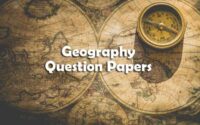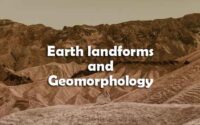UPSC Geography Questions and Answers
UPSC Geography Questions paper pdf for examination is given below. Union Public Service Commission geography question papers direct download links are given in this section. Hence, download the UPSC Geography Previous Paper pdf below.

Union Public Service Commission Geography Previous Papers Pdf help the applicants in their preparation. UPSC Geography previous papers are available here to download. This is the good news for the candidates who are preparing for Union Public Service Commission.
Aspirants can download Union Public Service Commission Model Papers on Geography pdf through online mode. Applicants who are preparing for Union Public Service Commission written exam can download UPSC Geography Sample questions from our website for free.
Questions and Answers on Geography for UPSC
1. Concept of uniformitarianism stated by James Hutton Was further enhanced by :
(A) Louis Agassiz
(B) Charles Lyell
(C) John Playfaire
(D) Karl Gilbert
2. Which of the following is an example of residual mountain?
(A) Greater Himalaya
(B) Aravali
(C) Siwalik
(D) Balaghat range
3. Geosynclinal hypothesis was put as an explanation for ……………….. ..
(A) Orogeny
(B) Distribution of continents and oceans
(C) Crustal deformation
(D) Magma Chambers
4. Which one of the following is essential for Karstic landscape development ‘?
(A) Alluvial fans
(B) Glacial outwash
(C) Limestone bedrock
(D) Loess
5. Convectional Current Theory Was put forth by :
(A) Du Toit
(B) Lyell
(C) Wegner
(D) Holmes
6. ___________ is responsible for Green-house effect.
(A) Water vapour
(B) Dust particle
(C) Suspended material
(D) Argon
7. Who introduced the idea of ‘precipitation-evaporation ratio’ in climatic classification ?
(A) Koeppen
(B) Thornthwait
(C) Critchfield
(D) Strahler
8. Assertion (A) : “Loose, sandy soil surface heats up rapidly by day.”
Reason (R) : Air is an extremely poor conductor of heat.
Select the correct answer from the codes given below.
Codes
(A) Both (A) and (R) are true and (R) is correct explanation of (A)
(B) Both (A) and (R) are true but (R) is not the correct explanation of (A)
(C) (A) is true and (R) is false
(D) (A) is false but (R) is true
9. Which one of the following is not the distinctive feature of the stratosphere ?
(A) Its high moisture content
(B) Its stability compared to troposphere
(C) Its dryness
(D) Its high concentration of ozone
10. The ………………… .. pressure is dynamically induced belt.
(A) Equatorial low
(B) Sub-tropical high
(C) Polar high
(D) Tropical low
11. Theory of coral formation is put forth by …………….. .. .
(A) Charles Darwin
(B) W. M. Davis
(C) C.A.M. King
(D) John Pethick
12. Aleutian arc extends from :
(A) Gulf of Alaska to Kamchatka Peninsula
(B) Alaska to Siberia
(C) Canada to Japan
(D) Alaska to Japan
13. Vertical circulation of ocean Water is mainly controlled by …………… ..
(A) Volume of ocean Water
(B) Temperature of ocean surface water
(C) Ocean surface currents
(D) Atmospheric pressure at ocean surface
14. ___________ of the following is the most important element of the ecosystem.
(A) Food chain
(B) Food web
(C) Energy flow
(D) Ecological succession
15. In …………….. .. period domestication of animals was started.
(A) Paleolithic
(B) Pre-paleolithic
(C) Mesolithic
(D) Neolithic
16. What does “terrae-incognitae” refers to ?
(A) Territory in the human minds
(B) Unknown territories
(C) Unorganised territories
(D) Imaginary spaces
17. Who has firstly divided the World landmass into three continents i.e. Europe, Asia and Libya ?
(A) Erotosthenes
(B) Hipparchus
(C) Aneximendar
(D) Herodotus
18. Geography is concerned to provide accurate, orderly and rational description and interpretation of the variable character of the earth surface. This definition Was given by ____
(A) Yeates
(B) Taaffe
(C) Hartshorne
(D) Taylor
19. The concept of “Equator is a Great Circle” Was put forth by :
(A) Erotosthenes
(B) Hipparchus
(C) Ptolemy
(D) Pluto
20. Who has advocated that the Geography is an ideographic rather than Nomothetic ?
(A) Carl Ritter
(B) Hettner
(C) Peshel
(D) Penk
| RRB NTPC | AFCAT |
| TNPSC | SSC CHSL |
| MPSC | SSC CGL |
| UPSC | WBCS |
| CDS | BPSC |
21. In the urban context, “Twilight area” is referred to …………….. .. part of the city.
(A) Core
(B) Suburb
(C) Fringe
(D) City-Region
22. Which of the following is an unlikely impact on the areas of origin of migrants ?
(A) Depopulation
(B) Age-sex imbalance
(C) Increase of pressure on the environment
(D) Decrease in traditional activities
23. Laterite as a building material is used in villages of …………….. ..
(A) Punjab
(B) East Maharashtra
(C) Rajasthan
(D) Coastal Kerala
24. At an average, if the crude birth rate is 35-40/ 1000 and the crude death rate is 20-25/ 1000 Which is declining, then the country is …………….. .. stage of demographic transition.
(A) I
(B) II (a)
(C) II (b)
(D) III
25. The majority of the World’s population that is practicing agriculture is involved in …………… .. type of agriculture.
(A) Pastoral nomadism
(B) Subsistence farming
(C) Commercial grain farming
(D) Plantation agriculture
26. Which of the following is not a type of shifting cultivation ?
(A) Maquiladorus
(B) Milpa
(C) Chitemene
(D) Ladang
27. Assertion (A) : The labour is not infinitely mobile and the labour market does not operate freely under condition of perfect competition.
Reason (R) : Long distance labour cost and distance of labour movement have to be examined in the context of migration as a whole.
Which one of the following is correct ?
(A) Both (A) and (R) are true and (R) is the correct explanation of (A)
(B) Both (A) and (R) are true but (R) is not the correct explanation of (A)
(C) (A) is true but (R) is false
(D) (A) is false but (R) is true
28. Who has coined the term conservation of resources ?
(A) Gifford Pinchot
(B) Harold Rose
(C) P. Hagget
(D) Zirnmermann
29. Who is known as the pioneer for development of new geographical economics ?
(A) David Harvey
(B) De Blij
(C) Paul Krugman
(D) Andrew Cumbers
30. Who is the author of The World is Flat ?
(A) Appadurai
(B) Johnston
(C) Kuhn
(D) Friedman
31. ‘Exclave’ types are identified on the basis of which of the following ?
(A) Degree of separation
(B) Degree of political control
(C) Degree of economic control
(D) Degree of racial segregation
32. Which of the following provides philosophical underpinning to ethnomethodology ?
(A) Positivism
(B) Modernism
(C) Phenomenology
(D) Empiricism
33. ‘Sequent occupance’ suggested by Whittlesey is analogous to What ?
(A) Plant succession
(B) Animal succession
(C) Soil succession
(D) Climate succession
34. Who conceptuahsed ethnocracy?
(A) O. Yiftachel
(B) S. Kedar
(C) A. Ghanem
(D) J. R. Logan
35. _________ level of planning among the following.
(A) Local level planning
(B) Block level planning
(C) Five years planning
(D) Zonal level planning
36. Which one of the following is India’s rank in terms of Human Development Index among the countries of the World in?
(A) 130
(B) 128
(C) 127
(D) 129
37. In demographic planning, Which indicator Would not be the major concern ?
(A) Maternal Mortality
(B) Life Expectancy
(C) Infant Mortality
(D) Gender Disparity
38. In 1972, based on hierarchy of planning, Prof. Chandrashekhar divided India into …………… .. Macro and ……………. ..
(A) 13, 35
(B) 35, 13
(C) 15, 30
(D) 30, 15
39. Which of the following are prominent stations of Konkan railway route ?
(A) Ratnagiri and Madgaon
(B) Mangalore and Mumbai
(C) Chiplun to Thiruvananthapuram
(D) Mumbai to Udupi
40. India has often both floods and droughts because :
(A) The size of the country is very large
(B) The relief of India is highly uneven
(C) Monsoon causes heavy rainfall in a few months
(D) Behaviour of monsoon is highly variable
41. Which of the following is the easternmost major Himalayan tributary of Ganga river system?
(A) Tista
(B) Kosi
(C) Mahananda
(D) Ghaghara
42. Which bandwidth can be most useful for imaging from satellite in cloudy conditions ?
(A) 0.4 — 0.5 pm
(B) 0.4 — 0.7 pm
(C) 1.3 — 3.0 pm
(D) 1 mm — 1 In
43. Map generalization is mainly controlled by :
(A) Number of features to be represented
(B) Map scale
(C) Area to be mapped
(D) Projection of the map


